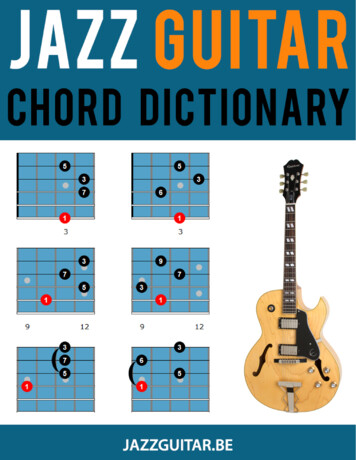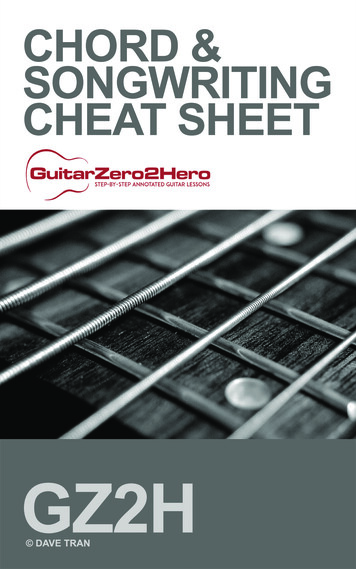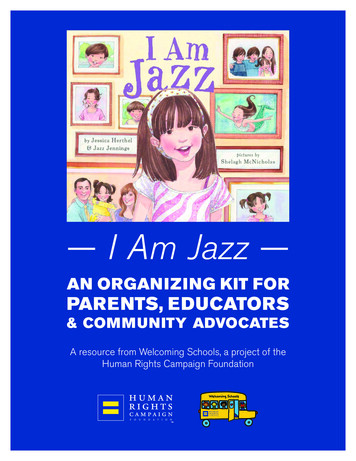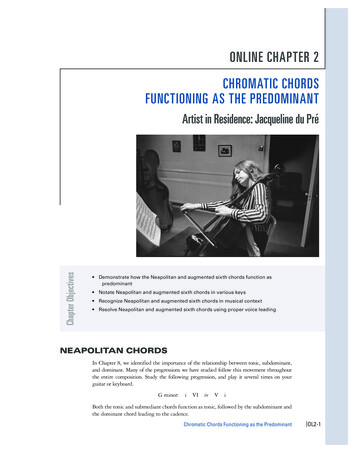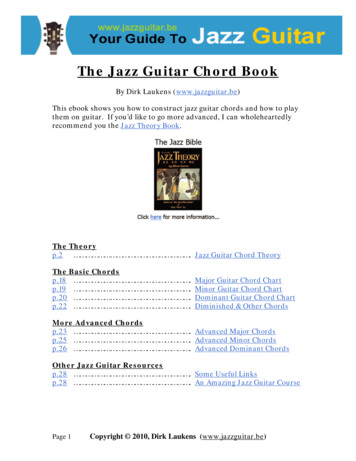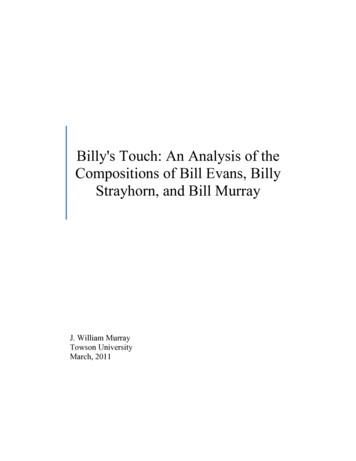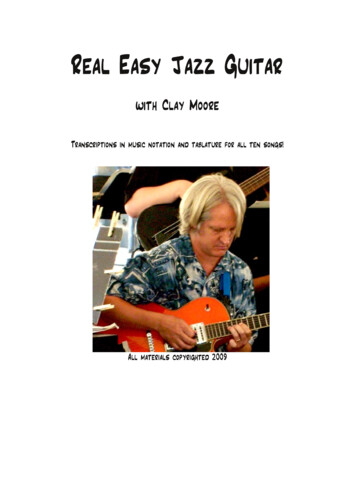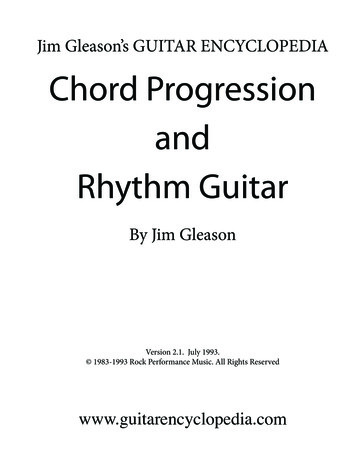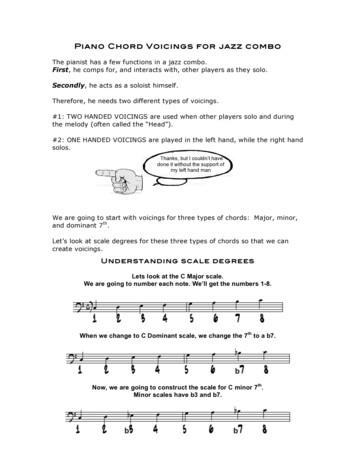
Transcription
Piano Chord Voicings for jazz comboThe pianist has a few functions in a jazz combo.First, he comps for, and interacts with, other players as they solo.Secondly, he acts as a soloist himself.Therefore, he needs two different types of voicings.#1: TWO HANDED VOICINGS are used when other players solo and duringthe melody (often called the “Head”).#2: ONE HANDED VOICINGS are played in the left hand, while the right handsolos.Thanks, but I couldn’t havedone it without the support ofmy left hand manWe are going to start with voicings for three types of chords: Major, minor,and dominant 7th.Let’s look at scale degrees for these three types of chords so that we cancreate voicings.U nd er sta nd i ng sca le de g re esLets look at the C Major scale.We are going to number each note. We’ll get the numbers 1-8.When we change to C Dominant scale, we change the 7th to a b7.Now, we are going to construct the scale for C minor 7th.Minor scales have b3 and b7.
Throughout this packet, we will show you voicings in twocategories: Category A and Category B.We will call voicings with the 3rd of the chord on thebottom CATEGORY A.We will call voicings with the 7th of the chord on thebottom CATEGORY B.We are going to start out with Major 7th voicings.For C Major, our two handed voicing looks like this:MAJOR 7THTWO HANDED VOICINGCategory ATricks of the TradePut your right hand pinky on the root of the chord and continue DOWN in 4ths.Or.Put your left hand pinky on the 3rd of the chord, and continue UP in 4ths-----.thLet’s try the Major 7 voicing in one other key.Here is the voicing for FMaj7:3369695511
DOMINANT 7THTWO HANDED VOICINGCategory ATo make a C dominant 7th voicing, or C7, we are going to change ONEnote from the major 7th voicing: The b7.3b795Notice that the only difference between the C7 and CMaj7 is that wereplace the 6th (A) with a b7 (Bb).Lets look at the dominant 7th voicing in one other key.Here is the voicing for F7:b3b79511
MINOR 7THTWO HANDED VOICINGCategory ATo turn a Major 7th chord into a minor 7th chord, add a b3 and b7.To turn a Dominant 7th chord into a minor 7th chord, just add a b3.C minor 7th, also spelled Cm7 or C-7 looks like this:b3b795Here is this same voicing for F-7b3b79511
REVIEWComparing the three types of two-handed CATEGORY A voicings.CMaj736951b7951b7b7995511C73C-7b3b3
MAJOR 7THONE HANDED VOICINGCategory ARemember, one handed voicings are played with the LEFT hand, while theright hand solos. Like our first set of two-handed voicings, these one-handedvoicings will all have the 3 rd on the bottom. These voicings can be played inmultiple octaves. We showed it in treble clef below.For C Major, our one-handed voicing looks like this:36Lets try it in one more key, G Major:369X9
DOMINANT 7THONE HANDED VOICINGCategory ARemember, to change any set of notes from major to dominant, we onlyneed to change the 7 th to a flat 7th.Our one-handed C7 voicing looks like this:3b7Our one-handed G7 voicing looks like this:3b799
MINOR 7THONE HANDED VOICINGCategory ARemember, to go from major to minor, we need to flat both the 3rd and the7th.Our one-handed C-7 voicing looks like this:b3b7Our one-handed G-7 voicing looks like this:b3b799
REVIEWComparing the three types of CATEGORY A one-handed voicingsCMaj7379C73b79b3b79C-7
Category B VoicingsNext, we are going to move on to voicings with the 7th on the bottom.We are going to call these voicings CATEGORY B.MAJOR 7THTWO HANDED VOICINGCategory ALike our Category “A” voicing, this voicing is all fourths.For C Major, our two handed voicing looks like this:736957369Here is this voicing for FMaj7:5Tricks of the TradeNotice that this voicing descends and ascends in fourths.Put your Right hand pinky on the ROOT, and descend in fourths. Or,Put your Left hand pinky on the seventh, and ascend in fourths.
DOMINANT 7THTWO HANDED VOICINGCategory BRemember, to make a C dominant 7th voicing, or C7, we are going tochange ONE note from the major 7th voicing: The b7.Look at our C7 voicing.b73695369Let’s look at this same voicing for F7.b7Tricks of the TradeThe right hand of this voicing is in still 4ths.The left hand is on the 3rd and b7th.5
MINOR 7THTWO HANDED VOICINGCategory BTo turn a Major 7th chord into a minor 7th chord, add a b3 and b7To turn a Dominant 7th chord into a minor 7th chord, just add a b3Here is the minor 7th voicing for C-7b7b3695Here’s this same voicing for F-7b7b3695Tricks of the TradeThe right hand of this voicing is in still 4ths. The left hand is on the b3rdand b7th.Practice TipPractice going from C Major 7 to C7 to C-7.Notice that ONLY YOUR LEFT HAND will change. Do this in all the keys.This is a great ear-training exercise.
REVIEWComparing the three types of one-handed voicings: category B.CMaj773695b73695b7b3695C7C-7
Now, let’s look at our Category B one handed voicings.Our Category B Voicings have the 7th on the bottom.MAJOR 7THONE HANDED VOICINGMajor 7th one handed735Here is this same voicing for FMaj7735Category B
DOMINANT 7THONE HANDED VOICINGC7b735F7b735Category B
MINOR 7THONE HANDED VOICINGC-7b7b35F-7b7b35Category B
REVIEWComparing the one handed voicings: Category BCMaj7735b735b7b35C7C-7
The Major ii V IYou will learn in combo that the Major ii V I is one of the mostimportant progressions in jazz tunes.Now that you know your category “A” and “B” voicings, these ii V I’sare simple.In a ii V I, the ii chord is always a minor 7th chordThe V chord is always a dominant 7th chordThe I chord is always a major 7th chord.The trick to playing these ii V’s is that we will always go from categoryA to B to A, or from category B to A to B.You will also notice that when we move from a minor 7th chord to adominant 7th chord, the 7th of the minor chord moves DOWN AHALF STEP.ii V ITWO HANDED VOICINGLet’s look at a ii V I in F Major:CATEGORY A to B to A
Now let’s look at the ii V I again, going from category B to A to Bin C Major.ii V ITWO HANDED VOICINGCATEGORY B to A to BHere is this same progression in F Major.
Finally, we’ll look at one-handed voicings for the ii V Iii V IONE HANDED VOICINGCATEGORY A to B to AHere is the progression in C Major.Here is the progression in F Major.ii V IONE HANDED VOICINGCATEGORY A to B to AHere is the one-handed voicing from Category B to A to B.
Part Two: Half-diminished and Altered Dominant ChordsNow it’s time to look at some other types of chords. These two types of chordsare part of the minor ii V i.In the Minor ii V I, the ii chord will be a m7b5 chord. This type of chord isoften called a “half-diminished” chord.Let’s start with the two handed m7b5 chord. We are again going to look at twodifferent half-diminished voicings.MINOR 7 b5TWO HANDED VOICINGThe first set of voicings has the root on the bottom:C-7b5F-7b5Rb5b7b3b6Tricks of the TradeNotice that this voicing is the same as the “Category A” dominant voicinga raised 5th up.For instance:Our C half-diminished chord is the same as the voicing for G#7Our F half-diminished voicing is the same as the voicing for C#7
Here is the second set of half-diminished voicings.MINOR 7 b5TWO HANDED VOICINGLet’s look at the voicing for C-7b5b5R4b7R4b3Here is the same voicing for F-7b5b5b7b3Tricks of the TradeNotice that this voicing is the same as the “Category B” dominant voicinga raised 5th up.For instance:Our C half-diminished chord is the same as the voicing for G#7Our F half-diminished voicing is the same as the voicing for C#7
Altered ChordsNext we are going to look at the voicings for altered chords. You can play thesevoicings when you see the symbols C7alt, C7#9, C7#9#5ALTERED DOMINANTTWO HANDED VOICINGCATEGORY AHere is the voicing for C7alt3b7#9b5b93b7#9b5b9Here is this same voicing for F7alt:Tricks of the TradeTo form C7alt, play a C dominant 7th “CATEGORY A” voicing.Then, raise the right hand (top three notes) up ½ a step.
ALTERED DOMINANTTWO HANDED VOICINGCATEGORY BC7altb73#5b9b5F7altb73#5b9b5Tricks of the TradeTo form C7alt, play a C dominant 7th “Category B” voicing.Then, LOWER the right hand (top three notes) by ½ a step.
MINOR 7 b5ONE HANDED VOICINGCATEGORY AC-7b5b3b5b7RF-7b5b3b5b7R
MINOR 7 b5ONE HANDED VOICINGCATEGORY BC-7b5b7 RF-7b5b7 Rb3b5b3b5
ALTERED DOMINANTONE HANDED VOICINGC7alt3#5 b7b9F7alt3#5 b7b9CATEGORY A
ALTERED DOMINANTONE HANDED VOICINGC7altb7 b9F7altb7 b93#53#5CATEGORY B
The minor ii V iLet’s put these voicings to use!In two handed voicings, you will have to jump from the ii chord to the V chord.The minor ii V i in c minor:The minor ii V I in f minor.
For one handed minor ii V I voicings, we are again either going to go fromcategory A to B to A, or from B to A to B.You can think of sliding your forefinger and thumb each out a half of step whenmoving from the ii chord to the altered dominant chord.Here is a minor ii V I in c minor.
Other VoicingsFinally, we are going to look at some other chord voicings.Diminished Chord (Co or Do)Diminished chords are made out of all minor thirds.The one- handed voicing for a diminished chord, is just this: all minor thirds.Here is one possibly C dim voicing.R b3b56This same voicing can be played in any inversion. Here are all the inversions forC dimished:
Two Handed Diminished VoicingTo make a two handed diminished voicing, put the root on the bottom. You’llhave a tri-tone in each hand, with a minor 3rd in between hands.Rb56#9
Sus ChordsFor sus chords, we don’t need any more voicings. Instead, play the minor 7thchord a 5th up. So, for C7sus, play a G-7 chord, and for F7sus, play a C-7 chord.Here are the voicings for C7sus and F7sus.Here are two one-handed voicings for C7sus. These are the same as our G-7one-handed voicings.Dominant 7b9 ChordsFor Dominant 7 b9 chords, use a diminished voicing from any chord tone but theroot.So, for C7b9, you can play a diminished voicing from either E, G, Bb or Db (b9).These voicings work for both one-handed and two-handed voicings.Here are four possibilities for C7b9:
Piano Chord Voicings for jazz combo The pianist has a few functions in a jazz combo. First, he comps for, and interacts with, other players as they solo. Secondly, he acts as a soloist hims
